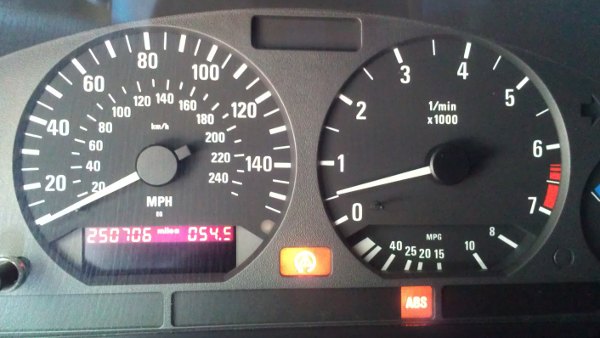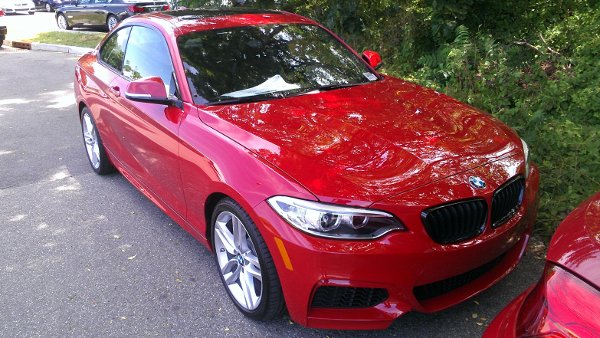Friday, July 4, 2014
ABS/ASC Warning Lights Illuminate
 Within a few drive cycles and probably 30 miles
after the recent front brake job I was doing errands and hopped in the car
to head home on the last leg when I was greeted with ASC (Traction Control)
and ABS warning lights illuminated in the cluster. Purely on instinct I assumed
this had something to do with a ABS speed sensor but I couldn't figure out
offhand what I might have done during the brake job to damage them. I considered
the possibility that perhaps I had put a small crack in the plastic case of
one of the sensors while removing it two years ago and it only now shorted
out.
Within a few drive cycles and probably 30 miles
after the recent front brake job I was doing errands and hopped in the car
to head home on the last leg when I was greeted with ASC (Traction Control)
and ABS warning lights illuminated in the cluster. Purely on instinct I assumed
this had something to do with a ABS speed sensor but I couldn't figure out
offhand what I might have done during the brake job to damage them. I considered
the possibility that perhaps I had put a small crack in the plastic case of
one of the sensors while removing it two years ago and it only now shorted
out.
The lights remained on for the drive home and, not surprisingly, playing with the ASC button had no effect, so I resolved to take it to the dealer for diagnostics the next day. The next morning I started the car and noticed the lights were no longer illuminated. At this point my diagnostic subroutine started to get worried – could this have been triggered by an ABS pump going bad? After all, the pump is self-tested at around the 10 MPH mark on each drive cycle and the lights illuminated just as I was getting moving in the last drive cycle. I fully expected at this point to see the lights illuminate again when the pump went through its self test but thankfully the cluster remained dark. I wound up driving to the dealer only to hear that my tech was on vacation so considering that there were no active warnings I decided to postpone the work a few days when he was expected to return.
A few days later I synced up with my technician and when I told him the story he quickly pointed out that the sensors are magnetic and that sometimes a flake of metal will fall off the old, rusting rotors during removal and get in the way of the sensor. He went on to suggest that driving could have dislodged the errant flake of metal and told me to bring the car back if the lights illuminate again.
2 Series Technology Update
I see my technician so infrequently these days that I always put any face time with him to good use. So naturally I asked a few questions that had been stewing in my brain regarding the new 2 Series, a possible replacement of sorts for my increasingly valuable E36.
The 2addicts forum is alive with discussion – a lot of it misguided, unfortunately – about how the car functions. This car is equipped with two special driving modes: “sport mode” and “sport plus”. While it was eventually sorted out that the modes are identical with the exception that sport plus enables DTC mode (which is merely a higher threshold for DSC operation, i.e. it allows more wheel spin and yaw rate before the nannies step in), someone sensationally indicated that it was not possible to disable DSC mode in sport plus mode. That's technically correct but only because DTC mode necessarily requires DSC enabled.
 When I ran this discussion by my technician he
confirmed that is the way it works, but it's still possible to disable DSC
for track use (or a bit of ill-advised hooliganism on the street) while gaining
the benefits of sport mode. The solution is simple – enable sport mode
(NOT sport plus) and then disable DSC via iDrive or by pushing and holding
the DSC button. So the message is BMW hasn't gone off the deep end quite yet
by eliminating the ability to disable DSC, especially in advance of any government
regulation on the topic.
When I ran this discussion by my technician he
confirmed that is the way it works, but it's still possible to disable DSC
for track use (or a bit of ill-advised hooliganism on the street) while gaining
the benefits of sport mode. The solution is simple – enable sport mode
(NOT sport plus) and then disable DSC via iDrive or by pushing and holding
the DSC button. So the message is BMW hasn't gone off the deep end quite yet
by eliminating the ability to disable DSC, especially in advance of any government
regulation on the topic.
My second question was about EPS (Electric Power Steering). I wanted to know what happens if power to the electric assist motor is ever disconnected. Would the rack then behave like a manual rack with the commensurate increase in steering forces when driving slowly or would the failure mode approximate that of the traditional hydraulic system in which steering forces are consistently higher than normal regardless of speed? My technician said the EPS failure mode is similar to that of hydraulic systems. It would no doubt have been preferable to disconnect the motor through a clutch mechanism of sorts so the car could be more easily controlled (at least at speed) in a reversionary mode but that would have likely introduced more cost and possibly a few more failure modes so I can see why the engineers didn't bother.
And with regard to all that's been said about the lack of steering feel my technician pointed out that may have been a valid concern of the earlier implementations but he just drove the first M4 that came into the dealership and said it was quite good in this respect. So the quotes from the M group in Roundel about them “tweaking” the system to match the expected level of feedback in a M car appear to be true. My only hope is that the M2 will follow suit. My technician also commented favorably on the overall performance of the M4, but that's to be expected when you have 400 lb-ft of torque on tap and a slightly lighter body as compared to the E9x.
Pictured is a 2014 228 I spotted on my way out of the dealership the other day. Despite the high shoulders mandated for crashworthiness I have to admit that is one nice looking car and mildly reminescent of my E46.
Mileage: 250800



